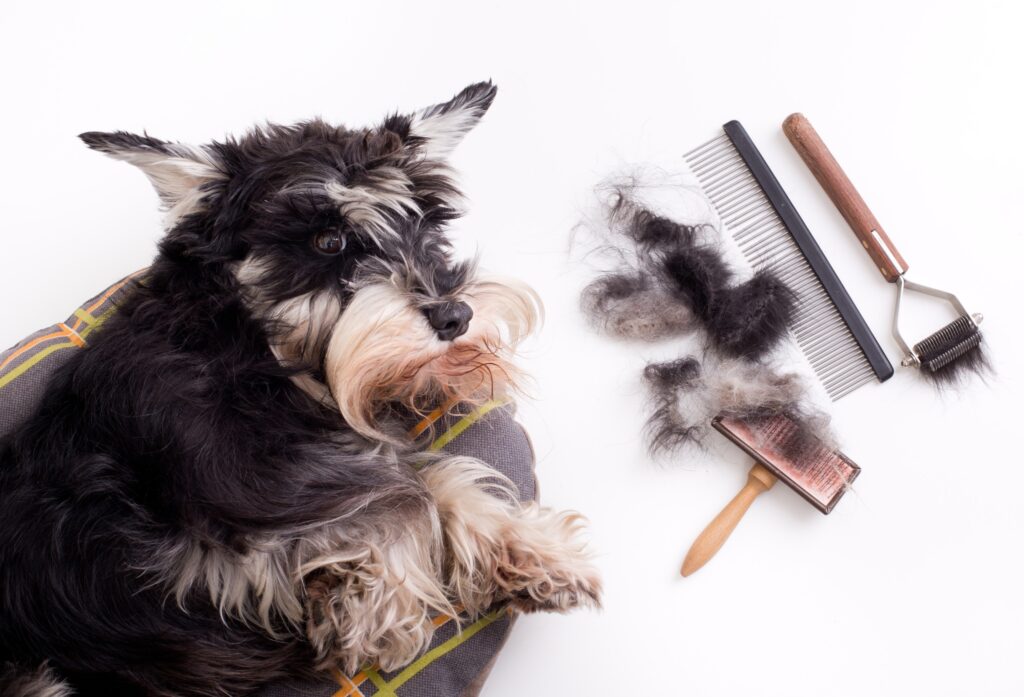Dog hair fall or hair loss is a common condition that happens to any breed, at any age. Also known for its medical term, Alopecia, is when a dog experiences unnatural hair loss or baldness that appears in several parts of the body. Sometimes, it affects the whole body causing complete hair loss.
This disorder should not be confused with shedding, which is a dog’s way of shedding fur. Shedding usually happens when old fur or damaged fur falls on its own, to be replaced sooner or later with new fur.
On the other hand, with alopecia or dog hair loss, is the loss of hair that is usually associated with other underlying causes or symptoms. It is caused by several factors, internal or external. It is important to know what causes them, what symptoms to look out for, and how to properly treat hair loss in dogs.
Symptoms of Hair Fall or Hair Loss in Dogs

The very first sign or symptom that any pet owner will notice when it comes to hair loss in dogs is the balding of any part of their body, and the hair does not grow back in the bald spot. Moreover, there are other physical and behavioural symptoms that you may notice.
The common symptoms of alopecia or hair fall in dogs:
- Overall hair thinning
- Loss of hair around the eyes and mouth
- Excessive shedding of hair
- Hair loss along the flank area
- Symmetrical bald patches that appear as the same patterns on the different sides of the body
- Scaly, dry skin
- Itchiness
- Redness or inflamed skin
- Excessive licking or grooming
- Skin from hair loss is discoloured
- Wounded or bleeding areas of hair loss
- Foul odour
The most common way to know it’s a hair loss condition when the skin is damaged, discoloured, and redness. It’s accompanied by dandruff or flaky skin that also makes the skin itchy. In some severe cases, the skin is crusty and oozing.
Causes of Dog Hair Fall

If you saw some of the symptoms manifest on your dog’s skin, and you are not sure of where it started, you can link it to the causes that led to this condition.
In some cases, if the symptoms do not manifest but balding still occurs, it can be due to hereditary or hormonal issues. These manifestations usually occur when the dog is still a puppy or during early adulthood. Select breeds have a hereditary condition that causes them to develop bald spots as well. The genetically predisposed conditions are harmless but untreatable.
On the other hand, the causes can be due to diseases, infections, and pest infestations. Hair loss due to mites, fleas, and ticks is one of the most common causes. It causes itching and irritation on the skin. Allergies from flea bites can cause hair loss in dogs – wherein the reaction from these bites will show in their behaviour such as excessive scratching and chewing that damages their coat.
The most common infection that causes dog hair fall is ringworms. It’s a contagious fungal infection that shows up as circular balding spots along with inflammation, lesions, and crusting.
Other causes of hair loss in dogs include:
- Pressure sores due to lying down on hard surfaces
- Friction from tight collars
- Allergic reactions to plants, chemicals, bug bites, etc
- Injuries
- Nervous chewing
- Diabetes
- Thyroid Issues
- Cushing’s Disease
- Sex hormone imbalance
- Chemotherapy
- Skin cancer
- Scarring
Treatment for Hair Loss in Dogs
Once the cause has been identified, there are corresponding treatments available to reverse hair loss in dogs. We highly recommend bringing your dog to the veterinarian for them to properly diagnose and treat this condition. They will also be the ones who will prescribe medications, suggest hair loss treatments, and even recommend supplements or shampoos that can help with hair growth.
There are several topical and oral treatments available for hair loss in dogs. Antibiotics are used for bacterial infections, antifungals to treat fungal infections, and steroids are used for skin conditions. It is also recommended to use antihistamines for allergic reactions and to take away the source of the allergies. If it’s food allergies, make sure to change it. On the other hand, since most allergic reactions are from pest bites, oral and topical flea treatments are also available to get effectively get rid of them before the skin condition worsens.
As for thyroid or hormonal disorders, hair loss treatment must be given as recommended by the veterinarian. As mentioned earlier, if the hair loss is due to genetics, the hair loss cannot be cured.
Lastly, aside from medications, choosing the right supplements, and shampoo, and switching up your dog’s diet can also help with renewing your dog’s hair growth. The most recommended ingredients for food and supplements usually contain fish oil, vitamin A, and vitamin E which are good for keeping your dog’s coat healthy.
Conclusion
Dog hair loss is a common disorder that causes balding in several spots or complete hair loss on the dog’s body. The symptoms of the alopecia or hair loss can show up as skin conditions and through your dog’s behaviour. It can also be due to genetics that are passed down from the parents which are, unfortunately, untreatable.
There are several causes of hair loss in dogs that are mostly due to diseases, infections, or pests. In response, dog hair loss treatments are available in different forms that can help accelerate fur growth. When in doubt, make sure to visit your veterinarian, so they can properly find out the cause of the hair loss and recommend the right treatment for your dog.


